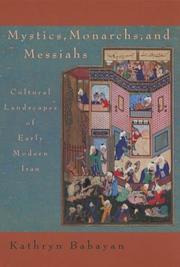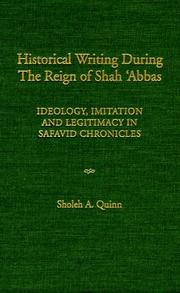| Listing 1 - 9 of 9 |
Sort by
|
Book
ISBN: 2262095752 2262095752 9782262095758 9782262095758 Year: 2023 Publisher: Paris: Perrin,
Abstract | Keywords | Export | Availability | Bookmark
 Loading...
Loading...Choose an application
- Reference Manager
- EndNote
- RefWorks (Direct export to RefWorks)
L'histoire des neuf Shahs qui ont fondé l'Iran moderne. Sophis, Safavides, Séfévides... Si les noms qui désignent cette dynastie sont nombreux, ce qu'elle accomplit est unique : entre 1501 et 1722, elle fait vivre à l'Iran l'âge d'or de son histoire. Après une période médiévale qui voit de nombreux empires éphémères régner sur une zone mal définie, les neuf Shahs qui se succèdent à la tête de la Perse pendant deux siècles parviennent à mettre en place un pouvoir fort et centralisé, à fédérer un territoire composite, à stabiliser les frontières face aux forces étrangères – essentiellement ottomanes et ouzbèques –, à redéfinir juridiquement les rapports entre les pouvoirs internes et, enfin, à imposer le chiisme comme religion d'État. Cet apogée est en grande partie dû au plus illustre des souverains de cette lignée, le grand Abbas Ier (1587-1629). Réformateur, administrateur, conquérant, il est également visionnaire : en choisissant de déplacer la capitale à Ispahan, il sait qu'il va faire de son empire une puissance importante sur le plan international. Et en effet, cette " moitié du monde " ouvre le pays aux échanges politiques, diplomatiques, commerciaux, religieux et artistiques. Alors quelles faiblesses précipitent la chute de la dynastie sous les assauts afghans au XVIIIe siècle ? S'appuyant sur de nombreux récits iraniens et occidentaux, Yves Bomati nous fait revivre deux cents ans d'histoire méconnue. Romanesque mais en rien romancée, cette synthèse retrace toute l'épopée des grands Sophis, l'héritage durable qu'ils ont laissé en Iran et leur imprévisible chute

ISBN: 0932885284 9780932885289 Year: 2002 Volume: 35
Abstract | Keywords | Export | Availability | Bookmark
 Loading...
Loading...Choose an application
- Reference Manager
- EndNote
- RefWorks (Direct export to RefWorks)
Sufism --- Mysticism --- Soufisme --- Mysticisme --- History. --- Islam --- History --- Histoire --- Histoire. --- Iran --- Safavid dynasty, 1501-1736 --- Sufism - Iran - History --- Iran - History - Safavid dynasty, 1501-1736
Book
ISBN: 9781845118907 1845118901 Year: 2009 Publisher: London : Tauris Academic Studies,
Abstract | Keywords | Export | Availability | Bookmark
 Loading...
Loading...Choose an application
- Reference Manager
- EndNote
- RefWorks (Direct export to RefWorks)
"The Safavid dynasty originated as a fledgling apocalyptic mystical movement based in North-West Iran, and grew into a large, cosmopolitan Perso-Islamic empire stretching from Baghdad to Heart. During this golden era in Iran's history, from the sixteenth to the eighteenth centuries, functionaries of the Safavid 'state' introduced and moulded a unique and vibrant political discourse which reflected the social and religious heterogeneity of the sixteenth-century Iranian landscape. Beginning with the millenarian-minded Shah Isma'il and concluding with the autocrat par excellence, Shah Abbas, Colin P. Mitchell elucidates the phenomenon of state-sponsored rhetoric, and helps us understand how this dynasty articulated their political and religious sovereignty during a crucial phase of Iranian history."--Jacket.
Iran --- History --- Politics and government. --- Politique et gouvernement --- Ṣafavid Dynasty (Iran). --- Politische Rede. --- Schiiten. --- Safawiden, --- Safawiden. --- 1501-1736. --- Iran.
Book
ISBN: 9783700173083 3700173083 Year: 2013 Volume: 841 71 Publisher: Wien Österreichische Akademie der Wissenschaften
Abstract | Keywords | Export | Availability | Bookmark
 Loading...
Loading...Choose an application
- Reference Manager
- EndNote
- RefWorks (Direct export to RefWorks)
Alḳas Mirza, --- Iran --- Turkey --- History --- Relations --- Alḳas Mirza, - 1516-1550. --- Iran - History - Ṣafavid dynasty, 1501-1736 --- Turkey - History - Süleyman I, 1520-1566 --- Turkey - Relations - Iran --- Iran - Relations - Turkey
Book
ISBN: 9781848853546 1848853548 Year: 2011 Publisher: London Tauris
Abstract | Keywords | Export | Availability | Bookmark
 Loading...
Loading...Choose an application
- Reference Manager
- EndNote
- RefWorks (Direct export to RefWorks)
The Safavid period is in immensely rich chapter in the history of Iranian architecture. Kishwar Rizvi examines the intersection of popular piety and imperial ideology through an in-depth look at the production and patronage of the shrine of Shaykh Safi. As the former political base of the ruling dynasty, the shrine is a reservoir of insight into the cultural and religions interaction between the regional Muslim empires of the early Modern period. From its inception as a modest Sufi lodge to its apogee as the dynastic mausoleum of the Safavid Shahs, Rizvi recounts the pivotal moments in the shrine's development as a manifestation of political authority and a centre of religious worship. The Safavid Dynastic Shrine offers a pointed analysis of the structural representation of imperial power throughout the shrine's numerous renovations. Rizvi reveals how architecture, as both symbol and artefact, was instrumental in the formation of the empire's cult of kingship that prevailed throughout the first half of the sixteenth century. Through a detailed survey of blueprints, pilgrimage manuals and property transactions. Rizvi argues that the transformation of the Sufi institution into a regal dominion was not a simple transfer of power, but a constant negotiation between the diverse bases of clientele who paid homage to the shrine. The vast network of pilgrims and patrons, which transcended both geographical and religious divisions, demonstrates the fluid nature of the borders between neighbouring empires and challenges the traditional assumptions about the centres of power and their periphery in the early modern period. The Safavid Dynastic Shrine explores Iranian architecture not only as a monument of imperial legacy, but also as an expression of cultural diversity and aesthetic significance. --Book jacket.
Architecture, Safavid --- Architecture and state --- Architecture séfévide --- Architecture --- History --- Politique gouvernementale --- Histoire --- Ṣafī al-Dīn, --- Iran --- Civilization --- Civilisation --- Architecture and state. --- Architecture, Safavid. --- Ṣafī al-Dīn, --- 1501-1736. --- Shrines. --- History. --- Iran.
Book
ISBN: 9783700172635 370017263X Year: 2013 Volume: 835 70 Publisher: Wien: Österreichische Akademie der Wissenschaften,
Abstract | Keywords | Export | Availability | Bookmark
 Loading...
Loading...Choose an application
- Reference Manager
- EndNote
- RefWorks (Direct export to RefWorks)
Prices --- Wages --- Cost and standard of living --- History --- Jongh, Wollebrandt Geleynssen de, --- Iran --- Economic conditions --- Prices - Iran - History --- Wages - Iran - History --- Cost and standard of living - Iran - History --- Jongh, Wollebrandt Geleynssen de, - 1594-1674 --- Iran - Economic conditions --- Iran - History - Ṣafavid dynasty, 1501-1736

ISBN: 0874806437 Year: 2000 Publisher: Salt Lake City : University of Utah Press,
Abstract | Keywords | Export | Availability | Bookmark
 Loading...
Loading...Choose an application
- Reference Manager
- EndNote
- RefWorks (Direct export to RefWorks)
History --- Historiography --- Methodology --- Iran --- República Islâmica do Irã --- Irã --- Persia --- Northern Tier --- Islamic Republic of Iran --- Jumhūrī-i Islāmī-i Īrān --- I-lang --- Paras-Iran --- Paras --- Persia-Iran --- I.R.A. --- Islamische Republik Iran --- Islamskai︠a︡ Respublika Iran --- I.R.I. --- IRI --- ايران --- جمهورى اسلامى ايران --- Êran --- Komarî Îslamî Êran --- Historiography. --- Histoire --- 1501-1736 (Séfévides) --- Méthodologie --- Historiographie
Book
ISBN: 9783700165576 3700165579 Year: 2009 Volume: 47 790 Publisher: Wien Österreichische Akademie der Wissenschaften
Abstract | Keywords | Export | Availability | Bookmark
 Loading...
Loading...Choose an application
- Reference Manager
- EndNote
- RefWorks (Direct export to RefWorks)
Heerführer --- Safawiden --- Rustam Khan, --- Rustam Han --- Iran --- History --- Rustam K̲h̲ān, --- Heerführer --- Rustam Ḫān --- K̲h̲ān, Rustam, --- Rostam Khan, --- Saak'adze, Rostam Xān, --- República Islâmica do Irã --- Irã --- Persia --- Northern Tier --- Islamic Republic of Iran --- Jumhūrī-i Islāmī-i Īrān --- I-lang --- Paras-Iran --- Paras --- Persia-Iran --- I.R.A. --- Islamische Republik Iran --- Islamskai︠a︡ Respublika Iran --- I.R.I. --- IRI --- ايران --- جمهورى اسلامى ايران --- Êran --- Komarî Îslamî Êran --- Rustam K̲h̲ān, - -1643 --- Iran - History - Ṣafavid dynasty, 1501-1736 - Sources
Book
ISSN: 22128662 ISBN: 9789004345645 9004345647 900434568X 9789004345683 Year: 2017 Volume: 3 Publisher: Boston ; Leiden : Brill,
Abstract | Keywords | Export | Availability | Bookmark
 Loading...
Loading...Choose an application
- Reference Manager
- EndNote
- RefWorks (Direct export to RefWorks)
In Opposition to Philosophy in Safavid Iran , Ata Anzali and S. M. Hadi Gerami offer a critical edition of a hitherto unpublished manuscript that is arguably the most erudite and extensive polemical work against philosophy and philosophical mysticism from the Safavid period. The introduction offers an extensive and in-depth analysis of the status of philosophy in the late Safavid period, placing Mulla Muhammad-Tahir Qummi’s (d. 1689) work in the broader context of the relevant cultural and intellectual developments of his time. The content of Hikmat al-‘arifin itself is divided between a refutation of many traditional philosophical arguments about the nature of God and His attributes and, more importantly for those interested in Safavid intellectual history, attacks on Mulla Sadra and his students for synthesizing fundamental elements Ibn ‘Arabi’s thought into the framework of traditional philosophical discourse.
Islamic philosophy --- God (Islam) --- Iran --- Early works to 1800 --- Attributes --- History --- Qummī, Muḥammad Ṭāhir, -1686 or 1687. --- Arabic philosophy --- Muslim philosophy --- Philosophy, Islamic --- Philosophy, Arab --- Qummī, Muḥammad Ṭāhir, --- República Islâmica do Irã --- Irã --- Persia --- Northern Tier --- Islamic Republic of Iran --- Jumhūrī-i Islāmī-i Īrān --- I-lang --- Paras-Iran --- Paras --- Persia-Iran --- I.R.A. --- Islamische Republik Iran --- Islamskai︠a︡ Respublika Iran --- I.R.I. --- IRI --- ايران --- جمهورى اسلامى ايران --- Êran --- Komarî Îslamî Êran --- Islamic philosophy - Iran - Early works to 1800 --- God (Islam) - Attributes - Early works to 1800 --- Iran - History - Ṣafavid dynasty, 1501-1736 - Sources --- Qummī, Muḥammad Ṭāhir, -1686 or 1687. - Ḥikmat al-ʻārifin
| Listing 1 - 9 of 9 |
Sort by
|

 Search
Search Feedback
Feedback About UniCat
About UniCat  Help
Help News
News